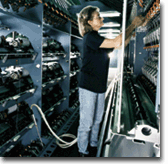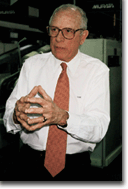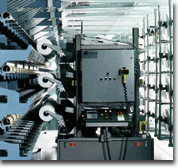Yarn ManufacturingBy Eric Vonwiller, Technical Editor Tops In
Textured Yarn
Investment in cutting-edge technology keeps costs low and Unifi on top.The impression
gained from touring any one of Unifis state-of-the-art manufacturing sites can be summed up in one
word awesome. Awesome not only in terms of the sheer dimensions of the facilities, but also in
terms of the technology used to create a world-class texturing operation. Maybe the companys motto
should be changed from Quality Through Pride to Quality Through Automation. ATI recently had the
opportunity to visit two Unifi texturing plants Yadkinville and Madison to see what keeps this
behemoth competitive in a cutthroat world market. Competition from Asia has taken its toll, and the
company is learning to weather the storm.In addition to looking at the companys technology, Unifis
chairman and founder G. Allen Mebane shares his thoughts on new markets, overseas competition,
future growth and company diversification. Investment In The Future

According to Mebane, $500 to 600 million has been spent over the past four years on capital
investment to modernize all plants in the Unifi group. The company should be through with its
present investment program by the end of Summer 1999. At that point, the oldest equipment will be
from 1990.Founded in 1971, the company is a leader in texturing nylon and polyester yarn. Unifi
feels that if it wants to stay competitive it must take out the labor equation for making yarn and
fiber. The company has added a lot of computer-aided manufacturing. This eliminates the need for
personnel for typical physical heavy-load work and repetitive tasks.Mebane expressed that
automation was the major focus of the investment and it practically triggered a chain reaction,
from state-of-the-art production equipment to re-thinking the entire manufacturing and distribution
process.As a result of the vast automation throughout the companys plants, Mebane said that the
internal systems group will soon offer Unifis computer-aided technology with its own Enterprise
System to other interested parties. The companys European operation in Letterkenny, Ireland, is
continuously gaining market share in Europe and has become the most profitable operation in the
group. Roughly 1,200 to 1,300 tons a week are shipped from the Letterkenny operation into the
European market. Twisting and dyeing is now in place and are just the first steps for further
expansion.Mebane said that Unifi is ready to go offshore with plants where the company has already
built up sales. By now, he said, they understand the needs of such markets and can establish
targeted manufacturing. Winning Strategies

For what we do, we are pretty diverse, and we have a habit of getting paid for what we do,
Mebane quipped. We have a great balance sheet and we are in great shape to compete.Unifi was able
to show about a 9.4-percent after-tax profit in 1997 and will be in a similar bracket for 1998, but
world markets have taken their toll. The companys stock price went from around $40 at the beginning
of last year, to just $12 in October. It is now in the $18 range. The company recently posted a
second-quarter loss compared to the same period last year. Unifi cites the Asian situation and
imports as causes of its current financial woes.Unifi considers itself a processor and distributor
of chemical fibers rather than a textile mill. For Unifi, this is an important distinction, and the
entire company philosophy is based on this. They measure how many pounds of textured yarn per
man-hour year are produced and compare that to the world competition.Mebane pointed out that cost
in 1968 was approximately 13 to 14 cents per pound of labor to produce 150-denier textured
polyester. Today it is less than 4 cents a pound.In his philosophy, labor and electricity compete
with each other, and where automation makes sense, labor must be eliminated, especially in the long
run, to stay competitive in the world market.We have the same amount of overhead in a plant that
makes 4 million pounds a week of textured yarns as we had in our first plant in 1971 that ran
300,000 pounds a week.Mebane has great ambitions to go beyond the respectable market share the
company already has in the textured polyester and nylon business. He is certain that Unifi does a
better job in planning and organizing than others do and wants to focus Unifi on the total yarn
market, to show customers economies that will allow things to be done in the United States that are
not done in other parts of the world.The company has developed warps that you dont need to size.
This, of course, is related to filament yarns. The textured no-size warp yarn is an example that
Mebane sees as a typical application that could be used for innovative fabrics with the value-added
seal and higher profits than typical mainstream products.Unifi buys approximately 70 percent of all
the polyester fibers it uses. The rest is now produced internally. The company not only has
texturing as a value-added product line, it also offers draw warping, twisting and dyeing
throughout its plants.On the nylon production side, the company offers different covered yarn types
to achieve the value-added products that customers look for.The key for the business we have,
Mebane explains, is to cover your fixed cost with 70 percent of the turnover, then you can make a
lot of profit with the value-added items, which are the other 30 percent. Mebane sees this
philosophy as the key factor in maintaining momentum and staying profitable. Nylon
TexturingWith one million square feet of production area, Unifis production facility in Madison,
N.C., is impressive in size, but by far not the largest production plant the company has to
offer.Forty-one texturing machines, 31 of which are new Barmag AFKs with automatic doffing and 10
are Barmag L12 texturizers, provide great production capacity and superior yarn quality. The
Madison plant is set up for 40- to 150-denier nylon production, where single-end, two-ply and
four-ply yarns are run on the equipment.Clifford James, director of manufacturing for the Nylon
Division, explained that the new machines are able to run up to 1,000 meters per minute. With the
current setup, the plant is capable of producing 1.2 million pounds per week on the textured yarn
side, while conventional fine-denier covering averages approximately 125,000 pounds per week, and
the air covering machines produce approximately 200,000 pounds per week. In the final stage, the
plant will have 312 conventional ICBT covering machines with individually motorized Temco spindles
for the covering operation.Construction of this site began in May of 1997, and in October of that
year the company started installing the first machines. In January of 1998, production was started
with older production machines. Between January and July of 1998 all new machinery was
installed.The advantage of the new machinery is that it delivers state-of-the-art quality. The new
Barmags also allow individual take-ups for random doffing.This indirectly led to an increase in the
package weight. The Barmag UNITEN monitoring system monitors each threadline for tension and
quality throughout the entire process, and James emphasized that this is a significant advantage
when compared to the older systems.Packing is done at the machine, which is different from the
companys Yadkinville facility, where AGVs (automatic guided vehicles) transport the yarn to the
automated packing station. Nylon does not have the same high production levels as polyester does in
Yadkinville.Around 50 percent of the production sold to customers goes into socks, while the other
half is used for critical end-uses, such as circular knits and woven apparel products. Where
It All Started

Plant 5 in Yadkinville, N.C., is the original location where Unifi was founded by
Mebane.Today we basically have five texturing facilities on this site, said J. Gregory Sutton,
director of manufacturing.The plant has a total of 190 texturing machines. Running full capacity,
the company could produce around 9.5 million pounds of product per week, all textured polyester.
The denier range is 70 denier on the low end and 300 to 400 on the high end.There are about 2.8
million square feet under one roof housing all of the manufacturing facilities and warehousing.
Roughly 1,850 people work at the Yadkinville facility, which is considered the companys flagship
operation.Plant 5 was finished in October of 1996 and is home to 72 texturing machines. It has the
capacity to produce 3.5 to 4 million pounds of textured polyester a week, depending on the denier
mix in the plant. The range in this plant is 70 to 300 denier, with single- and two-ply as the
workhorse products.Barmag AFK texturing machines are installed with a different profile design for
polyester, as opposed to the nylon machines used in the Madison plant. The biggest difference today
is that there are very few commodity products produced at Unifi and may only be run on two to three
texturing machines.In this operation, a significant amount of automation is part of the texturing
process. The plants AGVs are tied in with the machine through a traffic control system that
dispatches AGVs out to the machine to pickup the packages. It brings them to an automated packing
system, then the packages are conveyed to an automated palletizing unit, and then stored in a rack
storage system.Unifi finished building its P.O.Y. spinning operation in June of 1998, and the first
pound of polyester was produced in January 1998. It then took about five months to get everything
fine-tuned from the beginning to the end of production. The P.O.Y. operation can produce around 3.5
million pounds of product per week. The basic products that are run today in this spinning plant
are 100-, 200- and 300-denier yarns, with the flexibility to produce various cross sections,
lusters and a wide range of filament counts. Partners In AutomationOn the automation side, the
plant opted not to go with an off-the-shelf package system.We worked with a group that helped us
with other automated systems and let them help us develop our systems for the P.O.Y. spinning site,
Sutton said. We started working very closely with Advanced Automation in Greenville, S.C. It has
been a good relationship. However, automation has always been extremely expensive. According to
Sutton, it is hard to put a finger on a dollar value for the payback when quality issues come into
play. But Unifi absolutely believes that the quality of all products is better as a direct result
of cutting-edge technology.For Plant 5, part of the responsibility was to focus on some of the
ergonomically unfriendly processes, such as lifting and moving packages.Those are the processes
that are detrimental to the health of the employees and will be the first to be automated, Sutton
said. Usually there are 20 to 25 percent that you really never can justify. We try to accept that,
and we never have gone into a process where we knew that a quarter of the last automation would run
the price tag up so high that we could never justify it. The Exporting FormulaWe have a
wonderful platform in the United States to export from, said Mebane, Most people dont realize this.
We have the lowest cost of energy in the world, we have the best infrastructure transportation-wise
in the world, and we have a good solid base of petrochemical raw materials. We have all the
ingredients to export. Unifi exports from the United States to 54 countries and exports out of
Europe to about 25 countries. Since the world market has been unpredictable at best and as
economies improve or deteriorate, Unifi has had the challenge of staying focused on a moving
target. Unifi started exporting in the early 70s, but by 1980 the company was accused of dumping
product into the European market.We went from 10-percent market share to zero, Mebane said. The
reason for that was that European auditors would not believe that Unifis yarns could rightfully be
produced so inexpensively in the United States.Mebanes concern is that a lot of countries can
export freely to the United States, but U.S. manufacturers can not export on an equal basis.We dont
mind competing with anyone in the world, but we do like to have (equal) access to their markets,
explained Unifis chairman.Mebane feels that economic and political situations in countries are
becoming more of a hindrance to U.S. exporters than actual local textile competition. In addition,
the currency devaluations in some countries make it practically impossible to participate in a
competitive process, but the rest of the industry is in the same boat.The economic situation with
some of the Far East imports has deteriorated so severely that some of Unifis customers simply can
no longer compete. Covering The BasesModernizing and automating the production plants and
offering value-added products to customers have become the key strategies for survival, but
diversification seems to play a major role in the future direction of the company.In cooperation
with a scientific team, Unifi has helped develop a process where yarn and fabric can be dyed
without using water or any effluent. The system is based on a carbon dioxide process where it
enters as a gas and liquifies under pressure. Once that happens, either a cleaning or a dyeing
process can take place.Mebane explained that an ad campaign is already under way and that this new
dry-cleaning business will become a national franchise called Hangers. At the present time three
test-markets have been selected. This new dry-cleaning technology will start a new business
activity for the Unifi group, and Mebane feels that a similar dyeing process will succeed.
Editors Note: For more information on Unifi, see News in this issue. Also see Setting The
Standard For Quality, ATI November 1998.
February 1999




